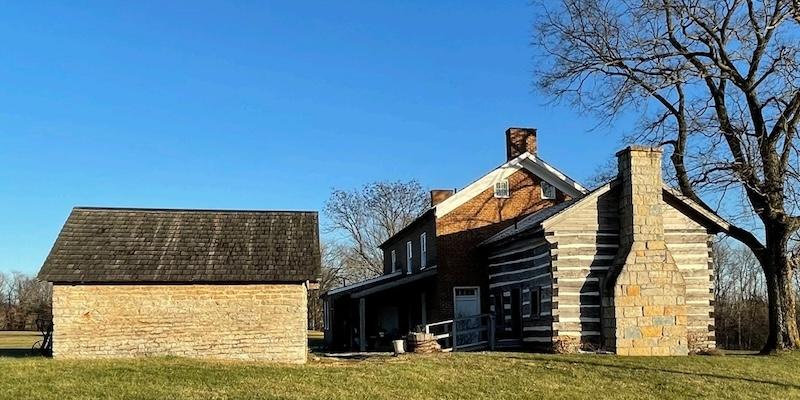
The John T. Wilson Homestead in Ohio is one of the new listings added to the Underground Railroad Network to Freedom Program / NPS
The National Park Service has added 14 new listings to the National Underground Railroad Network to Freedom Program. The network highlights over 800 places and programs linked to the Underground Railroad and the fight against slavery through escape and flight.
“These new listings, including the first in the Pacific Northwest, illustrate coast to coast efforts of freedom seekers and their allies to secure self-determination, liberty and justice for themselves and others," said National Park Service Director Chuck Sams. "Their brave and tenacious pursuit of freedom from oppression reflects the foundation upon which our nation was built and serves as a reminder that our country's journey to form a more perfect union is ongoing."
Created by Congress in 1998, the Network to Freedom recognizes the diverse experiences of freedom seekers who bravely escaped slavery and the allies who assisted them. It includes listings in 41 states, Washington, D.C., the U.S. Virgin Islands and Canada.
The new listings include the Charles Mitchell Escape Site on the Puget Sound Underground Railroad. Brought to the Washington Territory in 1855 by his enslaver, James Tilton, 12-year-old Mitchell escaped from Olympia in 1860, stowed away on a steamship bound for Victoria, British Columbia and freedom. Although discovered and apprehended by a ship captain determined to return him to slavery under the Fugitive Slave Act, Mitchell was rescued on the docks of Victoria by a fierce anti-slavery crowd. The next day Mitchell was declared legally free by the Canadian Courts and was adopted by the city's African Canadian community. Following the passage of the 13th Amendment, Mitchell returned to the United States and settled in San Francisco.
Also included are two sites in Michigan related to the journey of freedom seeker Perry Sanford — his burial place and the home of Erastus and Sarah Hussey, who assisted Sanford and many other freedom seekers.
Following are the additions to the National Underground Railroad Network to Freedom Program for the fall of 2024. Please note that some sites are privately owned. If a site is not open to the public, please respect the privacy of the owner.
Illinois
Andrew and Lucinda Allison Homesite (not open to public)
The Allisons were station masters who aided freedom seekers crossing the Mississippi River from pro-slavery Missouri into Illinois at the city of Quincy.
Site of the Illinois Central Railroad Passenger Depot in Cairo
The site was part of a rapid escape route for freedom seekers who hid on board train cars, often directly assisted by free Black residents of Cairo and employees of the Illinois Central Railroad.
Kansas
James and Clarinda Montgomery replica cabin - Fort Montgomery
The Montgomerys were abolitionists who resisted the attempts of pro-slavery settlers to force free state settlers from their claims. The replica cabin serves as a central point for the public to explore Linn County’s history in the resistance to slavery.
Kentucky
Isaac Downey's Escape from Globe Furnace
Issac Downey, an enslaved 40-year-old laborer at the Globe Furnace ironworks, escaped from Greenup County, Kentucky.
Michigan
Burial Site of Perry Sanford at Oak Hill Cemetery
Perry Sanford was a freedom seeker and self-emancipator who escaped enslavement in 1846 and eventually settled in Battle Creek after resisting attempts to re-enslave him.
Erastus and Sarah Hussey Store and House
The house and store served as an Underground Railroad station in Battle Creek, Michigan. The Hussey family provided food, shelter, and aid to countless freedom seekers.
Minnesota
Minneapolis Pioneers and Soldiers Memorial Cemetery
Formerly known as Layman’s, the oldest existing cemetery in Minneapolis is the final resting place of three freedom seekers and a Black conductor of the Underground Railroad.
New Jersey
Timbuctoo Community, New Jersey
Timbuctoo, a historic Black community established in 1826 by formerly enslaved and free Black individuals with the assistance of Quakers, stands as a beacon of resistance, resilience, and the unyielding pursuit of freedom.
New York
Florence Settlement 1848
Abolitionists Gerrit Smith and Stephen Myers played key roles in the Florence Settlement, a place where freedom seekers and freedmen could own land and become self-sufficient.
Ohio
Allen Chapel AME Church of Portsmouth, Ohio
Church members assisted freedom seekers on their journeys. The church continues to be a beacon for the city's African American community.
John T. Wilson: Conductor of Hope in the Scott Township Underground Railroad Network
Congressman John T. Wilson Homestead’s in Tranquility, Adams County served as a station on the Underground Railroad in a well-documented corridor of freedom-seeking activity.
South Carolina
Fort Sumter and Charleston Harbor
Charleston's shipping channels were both obstacles and pathways to freedom. More than 40 documented escapees made it through Confederate-controlled Charleston Harbor to reach United States gunboats or infantrymen and freedom.
Washington
Charles Mitchell Escape Site on the Puget Sound Underground Railroad
A network of African Canadian men helped Charles Mitchell, a 12-year-old enslaved boy, stow away in a steamboat traveling to Victoria, British Columbia. An antislavery crowd intervened when the ship captain attempted to take him back into enslavement and Mitchell was released and freed.
West Virginia
Chief Cornstalk's Stand: The Shawnee's Aid to Freedom Seekers
This memorial and burial site commemorate Chief Cornstalk's protection of the children of a female freedom seeker who sought refuge among the Shawnee. This act, preserved through Shawnee oral traditions, demonstrates the vital role Indigenous communities played in opposing slavery before the establishment of the Underground Railroad.

 Support Essential Coverage of Essential Places
Support Essential Coverage of Essential Places






